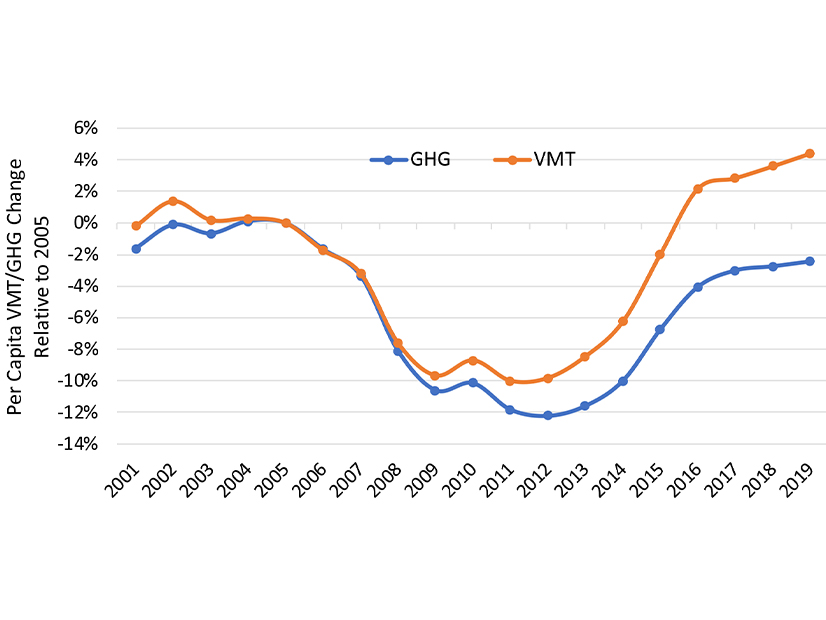
Reducing the number of miles driven by residents is one of California’s strategies for reducing greenhouse gas emissions, but state officials concede the goal will be difficult to accomplish.
The strategy appears in the California Air Resources Board’s climate change scoping plan, which lays out a pathway for the state to reach carbon neutrality.
A draft version of the plan, released in May, proposes reducing per-person vehicle miles traveled (VMT) by 12% by 2030 and 22% by 2045, as compared to 2019 levels.
During a CARB public hearing last week on the draft scoping plan, board member Diane Takvorian called for more aggressive VMT reduction targets: 25% by 2030 and 30% by 2035, compared to 2019 levels.
Takvorian asked CARB staff for further analysis of funding public transit versus spending money to get drivers to switch to ZEVs. Takvorian pointed to free-ride programs in the San Diego area that have helped boost transit ridership.
The San Diego Metropolitan Transit System (MTS) offered free rides in September 2021 to riders who used MTS’ new fare collection system. MTS’ total ridership that month was 4.92 million, 14% higher than August and 4% higher than in October, when the free-ride program was discontinued.
MTS is also offering free youth opportunity passes as a pilot program. In May, the first month of the program, the transit system’s number of youth accounts surged to 16,374, a 74% increase from the prior month, according to figures provided to NetZero Insider.
“We’re a car culture. We know how to help people buy cars,” said Takvorian, who represents the public on the CARB board. “What we don’t know how to do is change the culture so people ride public transit. We need to work on that more.”
Rajinder Sahota, CARB’s deputy executive officer for climate change and research, noted the challenges of reducing VMT.
“The problem is we’ve modeled very aggressive VMT targets in almost every scoping plan we’ve done,” Sahota said. “We’ve delivered on none of those. And so this is an entrenched problem in the scoping plan.”
Board member Daniel Sperling also expressed pessimism about the scoping plan’s VMT reduction goals.
“Ain’t gonna happen,” Sperling said. “It’s failed, and it’s going to continue to fail because of the land use patterns we have, the car-centric transportation system we have, the sprawl we have.”
Transit is already heavily subsidized and its share of passenger miles was falling even before the pandemic, said Sperling, who is a founding director of the Institute of Transportation Studies at the University of California, Davis
Making Transit Attractive
Gov. Gavin Newsom issued an executive order in September 2020 calling for all new cars sold in the state to be ZEVs by 2035. But even if the target is met, internal combustion cars will remain on the road for some time.
The draft scoping plan outlines a number of measures to reduce per-person VMT, such as increasing the affordability and convenience of public transit, so that it becomes a more attractive alternative to driving.
The plan proposes expanding infrastructure for active transportation, such as walking and biking, and building more housing in “transportation efficient” areas.
The draft scoping plan explores four scenarios for California to reach carbon neutrality. The scenario selected as the preferred alternative would bring the state to carbon neutrality by 2045. (See Draft Plan Seeks Calif. Carbon Neutrality by 2045 and Critics Tear into CARB Draft Climate Change Plan.)
The CARB board took no formal action during last week’s two-day hearing on the scoping plan. Board members weighed in on certain issues and asked staff for further analysis of topics such as VMT reduction.
More Cars per Household
CARB also released a report in June taking a closer look at VMT reduction efforts. Senate Bill 150, passed in 2017, requires the agency to prepare a report to the legislature every four years on the progress the state’s metropolitan planning organizations have made in reducing GHG emissions. CARB released the first SB 150 report in 2018.
“California is still not reducing GHG emissions from personal vehicle travel,” the new report said. “Per capita GHG emissions and per capita VMT continued to increase, though more slowly than in the 2018 progress report.”
The report found that California residents are driving to work more and carpooling less. The percentage of people who walk or bike to work, which was already small, is shrinking. At the same time, the number of vehicles per household is increasing and roadways are expanding, according to the report, which includes data through 2019.
Land use patterns are another factor contributing to VMT, the report said. People who live close to work, shopping and recreation don’t need to drive as much.
The report found that development in the state has become more compact since 2005, with the exception of the San Joaquin Valley, where development has become more spread out. Even where development is more compact, residents still can’t walk to “key destinations,” the report said.
The report said that the state must move beyond simply planning to reduce greenhouse gases and VMT.
“No matter how robust, regional plans alone cannot reduce emissions,” the report said. “It is critical that the state, including the legislature, focus attention on authorizing and funding strategies and on providing other policy tools that support implementation.”
